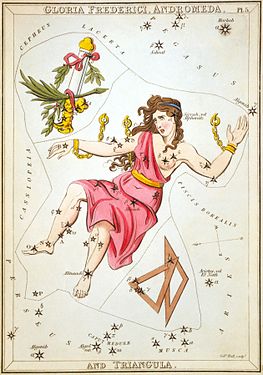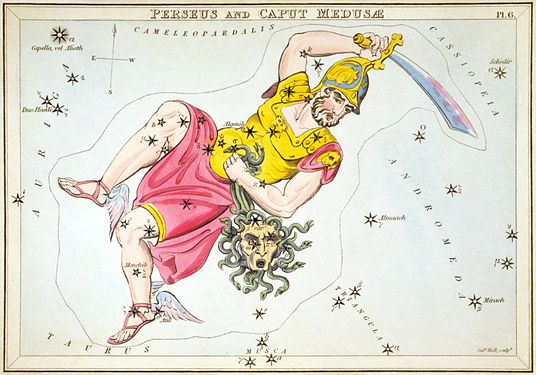Wikipedia:Featured picture candidates/Our light, it's true, is not worth mention
Set: Andromeda and Family - Starry Night Edition[edit]
Voting period is over. Please don't add any new votes. Voting period ends on 29 Mar 2014 at 05:30:35 (UTC)
All images are from Urania's Mirror, an 1824-5 set of star charts.
-
Plate 3: Cassiopeia. (A version oriented to the title text is also available.)
-
Plate 4: Cepheus
-
Plate 6: Perseus and Caput Medusæ
- Reason
- I don't want to put up thirty-some images at once, so I'm trying to provide reasonable groupings. Some of the parts of the sky form patterns related to their mythology or nature. For instance, The Sea, or Orion fighting Taurus to rescue the Pleiades, or, for our antipodean friends, Chamaeleon eating Musca, or Centaurus fighting Lupus. One grouping involves the myth of Perseus and Andromeda, both them and Andromeda's parents all appearing next to each other in the sky, which is today's nomination. Interestingly, an inability to properly put clothes on one's upper body runs in Andromeda's family.
- Articles in which this image appears
- All are in Urania's Mirror, each is also used in their respective constellations as linked, except Andromeda is not used in Triangulum.
- FP category for this image
- I believe they've been getting put into Wikipedia:Featured pictures/Artwork/Others, though I suspect that, by the time the set's done, we should consider giving it a new category.
- Creator
- Sidney Hall and Richard Rouse Bloxam, restoration by Adam Cuerden.
- Support as nominator --Adam Cuerden (talk) 05:30, 19 March 2014 (UTC)
- Support: useful, resolution is good, colors are nice, can be used individually (which helps put space between complaints about birds). — Crisco 1492 (talk) 09:32, 19 March 2014 (UTC)
- Support Saffron Blaze (talk) 21:08, 19 March 2014 (UTC)
- Support good images; it's too bad most people will likely pass over it - just one of these things you glance over and just move on. (I accidentally did that in your other nomination (Plate 10 and 27)). --CyberXRef☎ 02:42, 20 March 2014 (UTC)
- Support Nice colors, good restoration.--Godot13 (talk) 15:41, 20 March 2014 (UTC)
- Support Some are sharper than others for some reason, but very interesting indeed. – Kerαunoςcopia◁galaxies 17:22, 22 March 2014 (UTC)
- @Keraunoscopia: The LoC scans do vary a bit in quality, but keep well above the limit. Given it's about 450dpi, it's acceptable, I think. Though two images (not nominated yet - Cancer and Leo) were scanned much later at 600 dpi, and you'll definitely notice the difference between the more modern LoC equipment. Also, some of the variation is likely down to how much of the light blue paint was used, and - since there's a tendency for darker lines to appear sharper - the amount of fading and the exact settings I ended up with will matter. Adam Cuerden (talk) 19:42, 22 March 2014 (UTC)
- For the record, there's four more sets left: The Sea, The Cat and the Dog, Around the Pole, and Constellations of the Ecliptic. They're rough groupings, of course, and will exclude anything already promoted, and Orion and Pegasus will be excluded simply because the LoC hasn't yet scanned them - I've sourced substitutes, but they're under-resolution. Adam Cuerden (talk) 19:46, 22 March 2014 (UTC)
Promoted File:Sidney Hall - Urania's Mirror - Cassiopeia (image right side up).jpg --Armbrust The Homunculus 05:30, 29 March 2014 (UTC)
Promoted File:Sidney Hall - Urania's Mirror - Cepheus.jpg --Armbrust The Homunculus 05:30, 29 March 2014 (UTC)
Promoted File:Sidney Hall - Urania's Mirror - Gloria Frederici, Andromeda, and Triangula.jpg --Armbrust The Homunculus 05:30, 29 March 2014 (UTC)
Promoted File:Sidney Hall - Urania's Mirror - Perseus.jpg --Armbrust The Homunculus 05:30, 29 March 2014 (UTC)
- I added the images to Wikipedia:Featured pictures/Space/Understanding (and moved the others there too). Armbrust The Homunculus 05:30, 29 March 2014 (UTC)




